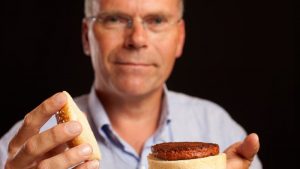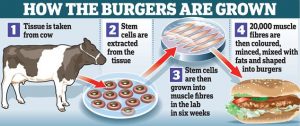There’s been a lot of work going on in labouratories around the World the past few years to develop the engineering techniques for producing various types of edible meats without the need for actual animals! This research has been referred to by various names either cultured meat, lab grown meat or even test tube meat. In fact it was back in August 2013 that Doctor Mark Post of Maastricht University in the Netherlands produced the first artificial hamburger patty. At a demonstration in London the hamburger patty was cooked by chef Richard McGeown of Couch’s Great House restaurant and eaten by the food critics Hanni Ruetzler and Josh Schonwald. The image below shows Doctor Post with his hamburger.

So how did the scientists do it, well much of the technology used was developed in the effort to study stem cells, the growth cells in embryos and fetuses that become muscle cells, skin cells or the cells of various organs. This is a branch of biotechnology known as tissue engineering. The image below illustrates the process.

In practice what the scientists have done is to take a few hundred adult muscle stem cells, known as a myoblast, from an animal, these are referred to as starter cells. The starter cells are then placed in a nutrient rich environment and given a protein that stimulates growth.
Once you have your cells growing you have to provide an organized structure to the developing tissue to make certain that all the cells have access to the nutrients. This prevents clumping which could leave some cells starving. Technically this structure is known as a scaffold and should be both edible, so that it doesn’t have to be removed, as well as flexible to facilitate cell growth. The most often used material is a collagen, that is a protein ladder or spiral structure formed into a three dimensional matrix to which the growing cells attach.
Once you get the whole process going there’s no theoretical limit to how much muscle can be produced from just a few cells. However many practical problems remain to be solved before large-scale commercial production can begin.
Nevertheless there are a dozen or more startup companies working on just that, commercialization of edible meat grown under labouratory conditions. And it’s not just beef, in the last few years chicken, duck, turkey, pork, fish and even frog, as in frog’s legs anyone, have been grown in the labouratory in sufficient quantity to provide a quick bite at a news conference. The images below show some of the different types of meat produced in the lab.


But why should we even want to manufacture meat as if it were steel or TV sets when we have always gotten our meat from farmers and ranchers, why should we change? In fact polls indicate that as much as 80% of people have no desire to ever try test tube meat, so it may be a while before you see cultured meat for sale in your supermarket.
Well there are two main reasons to move to large-scale production of cultured meat, efficiency and morality. Lets talk about efficiency first.
Even with today’s advanced chicken farms, pig farms and cattle ranches meat production is very inefficient and time consuming. As a rule of thumb the production of one kilo of meat requires 20 kilos of vegetable feed. Then there are the wasted parts of the animal carcass such as bones and chicken feathers. The inefficiency of meat production is the chief reason why even today meat is a rarity in the diets of half the world’s population.
The moral advantages of cultured meat are twofold. Firstly we just simply will no longer have to kill millions of animals for our food. A few cow cells, pig cells, chicken cells and etc can be grown indefinitely so the stain of the slaughterhouse could become a thing of the past. Its no wonder then that animal rights groups such as the People for the Ethical Treatment of Animals (PETA) are actually funding some of the research into cultured meat.
Environmental groups are also hopeful that cultured meat can reduce the impact of human civilization on our planet. The idea is that a one hectare meat factory can produce as much food as a 20 hectare farm or ranch perhaps even allowing some of the land now being used for agriculture to be returned to its natural, wild state.
Cultured meat is a technology still in its infancy. Whether or not it lives up to the promise many people have for it or not only time will tell. By the way, I’d certainly be willing to give a lab grown hamburger a chance!
